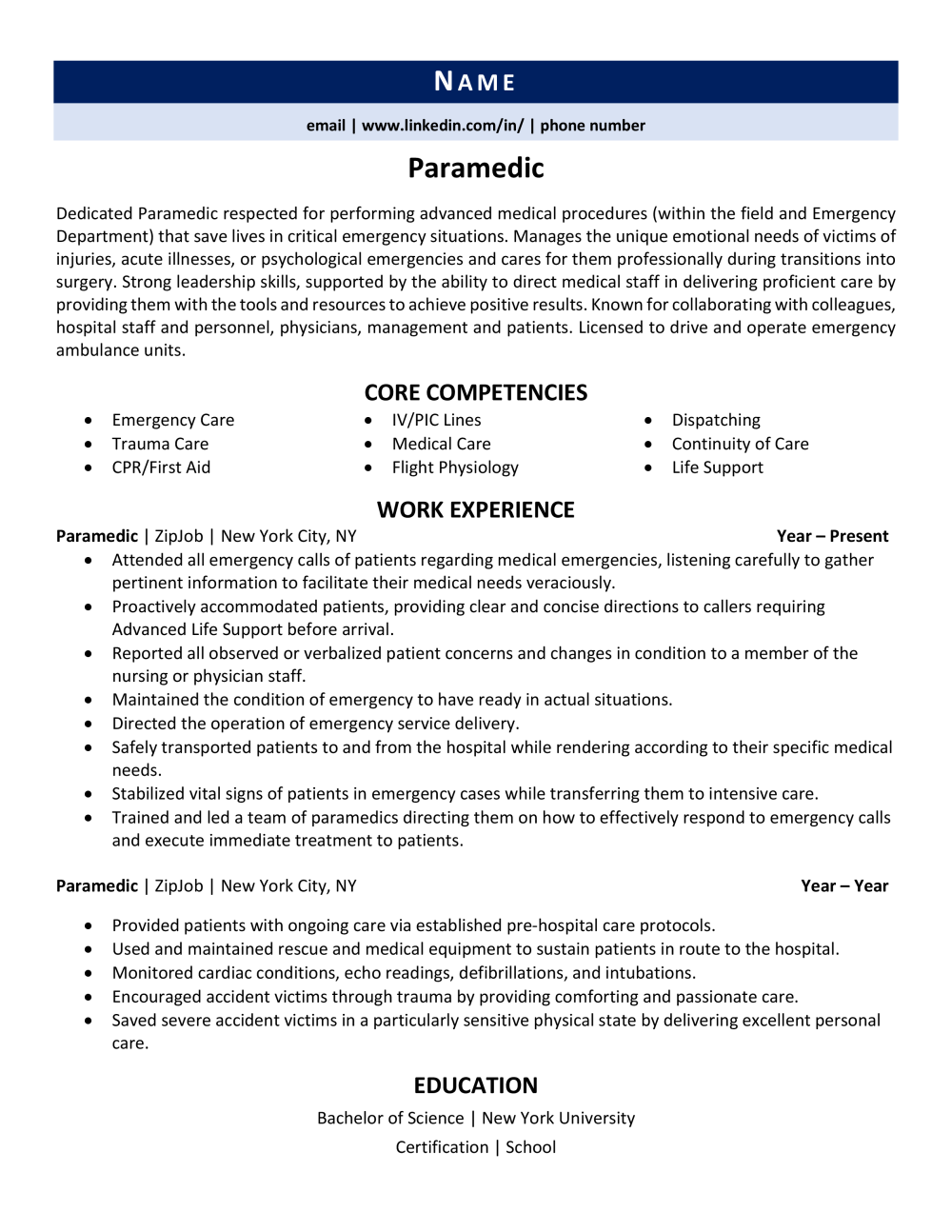Paramedic Sample
Download and customize our resume template to land more interviews. Review our writing tips to learn everything you need to know for putting together the perfect resume.
A Paramedic travels to emergencies to assist with medical problems and traumas. Below is a general Paramedic job description:
Paramedics are essential employees in emergency response situations, as they are the ones who respond to emergencies, such as 911 calls, and provide immediate treatment and relocation to a hospital. Paramedics are required to be alert and think quickly, and they must be able to lift bodies onto gurneys and transport them from the scene of an accident to an ambulance, which makes the work of a paramedic both physically and mentally demanding. Paramedics must also be able to administer CPR to patients, stop bleeding, and even use special equipment to bring patients back to life. Paramedics typically work outdoors, and spend most of their time in either an ambulance or emergency response helicopter. They typically work for hospitals and similar facilities with other paramedics, as well as doctors and nurses. Payscale
If this is the kind of job you want or you have, you're in the right place! We have a resume example for you and three tips from our professional resume writers below.
Expert Tip
You should never use a creative resume
Many job seekers think that an eye-catching resume template will help them stand out to hiring managers and increase their chances of landing an interview. This is a myth put out by resume builders that value design over content.
The truth is that most hiring managers prefer a traditional resume format.
Creative resume templates, like the one pictured here, can actually hurt your chances of landing an interview. Instead, you should use a basic resume format that quickly communicates your basic information and qualifications–like the one included below.
Paramedic resume (text format)
How confident are you feeling about your resume? If you need more help, you can always refer to the following resume sample for a position.
Name
Title
City, State or Country if international
Phone | Email
LinkedIn URL
PARAMEDIC PROFESSIONAL
Dedicated Paramedic respected for performing advanced medical procedures (within the field and Emergency Department) that save lives in critical emergency situations. Manages the unique emotional needs of victims of injuries, acute illnesses, or psychological emergencies and cares for them professionally during transitions into surgery. Strong leadership skills, supported by the ability to direct medical staff in delivering proficient care by providing them with the tools and resources to achieve positive results. Known for collaborating with colleagues, hospital staff and personnel, physicians, management and patients. Licensed to drive and operate emergency ambulance units.
CORE COMPETENCIES
Emergency Care
Trauma Care
CPR/First Aid
IV/PIC Lines
Medical Care
Flight Physiology
Dispatching
Continuity of Care
Life Support
PROFESSIONAL EXPERIENCE
Paramedic
ZipJob, New York NY | Year to Year
Responsibilities
Attended all emergency calls of patients regarding medical emergencies, listening carefully to gather pertinent information to facilitate their medical needs veraciously.
Proactively accommodated patients, providing clear and concise directions to callers requiring Advanced Life Support before arrival.
Reported all observed or verbalized patient concerns and changes in condition to a member of the nursing or physician staff.
Maintained the condition of emergency to have ready in actual situations.
Directed the operation of emergency service delivery.
Safely transported patients to and from the hospital while rendering according to their specific medical needs.
Stabilized vital signs of patients in emergency cases while transferring them to intensive care.
Trained and led a team of paramedics directing them on how to effectively respond to emergency calls and execute immediate treatment to patients.
Paramedic
ZipJob, New York NY | Year to Year
Responsibilities
Provided patients with ongoing care via established pre-hospital care protocols.
Used and maintained rescue and medical equipment to sustain patients in route to the hospital.
Monitored cardiac conditions, echo readings, defibrillations, and intubations.
Encouraged accident victims through trauma by providing comforting and passionate care.
Saved severe accident victims in a particularly sensitive physical state by delivering excellent personal care.
EDUCATION
Complete School Name, City, St/Country: List Graduation Years If Within the Last Ten Years
Complete Degree Name (Candidate) – Major (GPA: List if over 3.3)
Relevant Coursework: List coursework taken (even include those you are planning on taking)
Awards/Honors: List any awards, honors or big achievements
Clubs/Activities: List clubs and activities in which you participated
Relevant Projects: List 2-3 projects you have worked on
Everything you need to write your paramedic resume
Now that you’ve seen an example of a job winning Paramedic resume, here are some tips to help you write your own. You should always begin with a summary section. Remember to use basic formatting with clear section headings and a traditional layout. Finally, be sure to include top skills throughout your resume. We’ve included several examples common for Paramedic below.
Let’s start with your resume summary section.
1. Summary
The resume summary replaces the out-of-date resume objective. A summary outlines the most impressive parts of your resume for easy recall by your potential employer, while also serving to fill in personal qualities that may not appear elsewhere on the page. Remember that summaries are short and consist of pithy sentence fragments! You can check out the Paramedic resume example for more information!
Expert Tip
Always start with your most recent positions at the top of your resume. This is called reverse-chronological format, and keeps your most relevant information easy for hiring managers to review.
2. Formatting
Our experts recommend you start your resume with a resume summary, like the one above. Other common sections are Work Experience, Education, and either Skills or Core Competencies. Here are some guides from our blog to help you write these sections:
Some resumes will include other sections, such as Volunteer Experience or Technical Skills. When it comes to what sections you need to include on your resume, you will know best!
Other sections for you to consider including are foreign language skills, awards and honors, certifications, and speaking engagements. These could all be relevant sections for your resume.
3. Appropriate skills
Your resume should include all your skills that are relevant to your target job. Skills include both hard skills and soft skills. Hard skills are the technical know-how you need to complete a job, such as data analysis or HTML. You can include hard skills in your core competencies section. Soft skills are harder to quantify, so they require more information to explain your aptitude. Some top soft skill examples include communication, problem solving, and emotional intelligence. Use several examples of how you use your key soft skills throughout your work history, profile summary, and resume title.
4. Experience section
Your Work Experience section should make up the bulk of your resume. This section should include your relevant job titles, companies that employed you, and the dates you were employed.
Your Work Experience section should make up the bulk of your resume. This section should include your relevant job titles, companies that employed you, and the dates you were employed. Most people will finish this section by listing daily duties in short bullet points. Don't be one of them! To make your resume stand out, you need to add your accomplishments and key skills to your resume's Work Experience section. Here are three tips from our experts:
Use the STAR method to describe a situation, task, action, and result. This is adapted from a behavioral interview technique, so interviewers will recognize the format. it's also a great chance for you to organize your key accomplishments.
Don't forget about LinkedIn! The majority of employers are going to look you up on LinkedIn, so it's smart to make sure your LInkedIn profile is up to date and include your URL in your resume's contact section.
Always include a cover letter. Not everyone will bother, so it helps you look like a serious job applicant. It's also your chance to introduce yourself: who you are, why you're applying for this job, and how you want to proceed.
Let’s wrap it up!
Standout resumes will include a resume summary, a traditional reverse-chronological layout, and the skills and experience relevant to your job target. This resume example shows how to include those elements on a page. It’s up to you to insert your personal compelling qualifications.
Keep your resume format easy to scan by both humans and computers; our resume template is designed by our experts to satisfy both audiences. And be sure to include your own skills, achievements, and experiences. Job-winning resumes are resumes that successfully market you, leading recruiters and hiring managers to want to learn more!
Finally, emphasize your interest with a customized cover letter. When writing, remember that the resume and cover letter should support each other. Check out our cover letter tips and examples for more advice.
Didn’t get the specific answers you were looking for on this page? Hire a professional resume writer to get the advice you need to land your next job.
Related posts:




